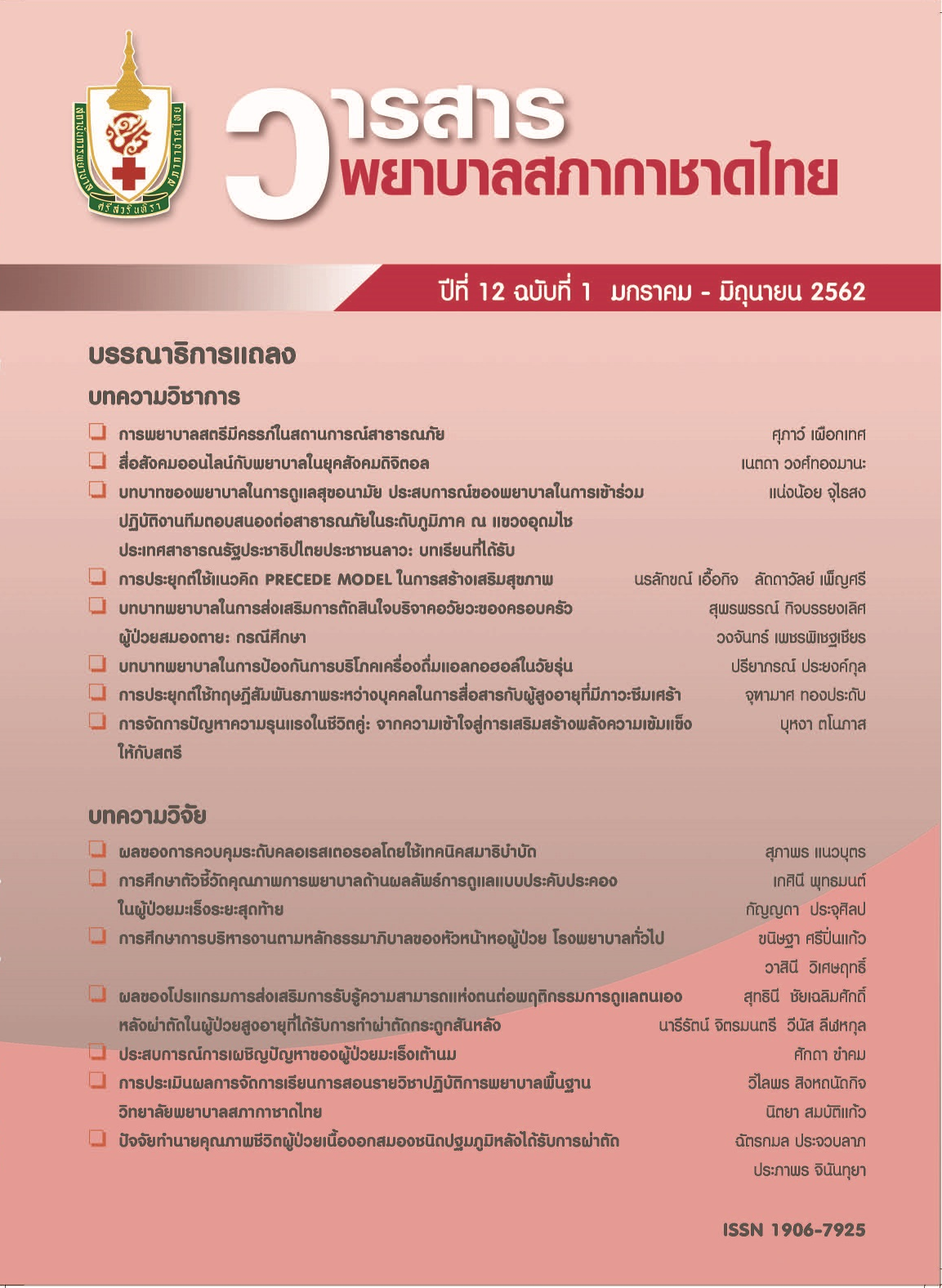Effect of the Perceived Self-Efficacy Promoting Program on Self-Care Behavior among Older Patients Post Laminectomy
Keywords:
self-efficacy promoting program, older patients, lumbar laminectomy, self-care behaviorAbstract
This was a quasi-experimental research with a post-test only, control group design to study the effects of the perceived self-efficacy promoting program on self-care behavior among post-surgical older patients. The participants were older patients who underwent a lumbar laminectomy at the neurosurgical ward, King Chulalongkorn Memorial Hospital between June 2016 and February 2018. Fifty participants were selected according to the inclusion criteria. They were divided into an experimental and control group of 25 participants each. The participants were matched based on their gender and the number of operated lumbar vertebrae. The experimental group received the self-efficacy promoting program for 5 days, and the control group received regular nursing care. Data were collected after the subjects received the program for 2 weeks using the personal information record form and the Self-Care Behavior after Surgery Questionnaire. Data were analyzed using descriptive statistics and the independent t-test.
The results showed that older patients in the experimental group who received the perceived self-efficacy promoting program had a significantly higher mean self-care behavior after surgery score than that of older patients in the control group who received regular nursing care (p<.001). This demonstrated that the program was effective in promoting the self-care behavior of older patients after lumbar laminectomy. Nurses should apply this program to older patients who undergo lumbar laminectomy similar to the participants in this study in other settings
References
2. งานเวชระเบียนและสถิติโรงพยาบาลจุฬาลงกรณ์ สภากาชาดไทย. สถิติผู้ป่วยโรงพยาบาลจุฬาลงกรณ์สภากาชาดไทย. กรุงเทพฯ: โรงพยาบาลจุฬาลงกรณ์ สภากาชาดไทย; 2557.
3. ตติยา จำปาวงษ์. ผลของโปรแกรมการส่งเสริมการรับรู้สมรรถนะของตนเองต่อการฟื้นฟูสมรรถภาพหลังผ่าตัดกระดูกสันหลังส่วนเอวแบบลามิเนกโตมี่ในผู้สูงอายุโรคโพรงกระดูกสันหลังส่วนเอวตีบ [อินเทอร์เน็ต]. 2560 [เข้าถึงเมื่อ 1 มี.ค. 2560]. เข้าถึงได้จาก: https://gsbooks.gs.kku.ac.th/60/nigrc2017/pdf/MMO13.pdf
4. Abbott AD, Hedlund R, Tyni-Lenne R. Patients' experience post-lumbar fusion regarding back problems, recovery and expectations in terms of the International Classification of Functioning, Disability and Health. Disabil Rehabil 2011;33(15-16):1399-408.
5. Abbott AD, Tyni-Lenne R, Hedlund R. Early rehabilitation targeting cognition, behavior, and motor function after lumbar fusion: a randomized controlled trial. Spine 2010;35(8):848-57.
6. Abbott AD, Tyni-Lenné R, Hedlund R. The influence of psychological factors on pre-operative levels of pain intensity, disability and health-related quality of life in lumbar spinal fusion surgery patients. Physiotherapy 2010;96(3):213-21.
7. Lee DY, Lee SH, Maeng DH. Two-level anterior lumbar interbody fusion with percutaneous pedicle screw fixation: a minimum 3-year follow-up study. Neurol Med Chir (Tokyo) 2010;50(8):645-50.
8. Archer KR, Seebach CL, Mathis SL, Riley LH, 3rd, Wegener ST. Early postoperative fear of movement predicts pain, disability, and physical health six months after spinal surgery for degenerative conditions. Spine J 2014;14(5):759-67.
9. Neblett R, Mayer G, Brede E, Gatchel J. The effect of prior lumbar surgeries on the flexion relaxation phenomenon and its responsiveness to rehabilitative treatment. Spine J 2014;(14):892–902.
10. Speerin R, Slater H, Li L, Moore K, Chan M, Dreinhofer K, et al. Moving from evidence to practice: models of care for the prevention and management of musculoskeletal conditions. Best Pract Res Clin Rheumatol 2014;28(3):479-515.
11. Reiter K. A look at best practices for patient education in outpatient spine surgery. AORN J 2014;99(3):376-84.
12. อัญชนา แก้วคา. การพัฒนาคุณภาพการเตรียมความพร้อมสาหรับผู้ป่วยก่อนผ่าตัดกระดูกสันหลัง โรงพยาบาลประสาทเชียงใหม่ [วิทยานิพนธ์ปริญญาพยาบาลศาสตร์มหาบัณฑิต]. เชียงใหม่: มหาวิทยาลัยเชียงใหม่; 2555.
13. Nielsen PR, Jorgensen LD, Dahl B, Pedersen T, Tonnesen H. Prehabilitation and early rehabilitation after spinal surgery: randomized clinical trial. Clin Rehabil 2010;24(2):137-48.
14. พรวิมล บุญมา. การส่งเสริมการรับรู้ความสามารถแห่งตนต่อพฤติกรรมการดูแลตนเองหลังผ่าตัดในผู้ป่วยโรคกระดูกสันหลังส่วนคอเสื่อม [วิทยานิพนธ์ปริญญาพยาบาลศาสตร์มหาบัณฑิต]. เชียงใหม่: มหาวิทยาลัยเชียงใหม่; 2552.
15. สุวคล โกสีย์ไกรนิรมล. ผลของโปรแกรมการส่งเสริมสมรรถนะของตนเอง ต่อการรับรู้สมรรถนะของตนเอง การปฏิบัติกิจวัตรประจำวัน และการเคลื่อนไหวของลำไส้ของผู้ป่วยที่ได้รับการผ่าตัดกระดูกสันหลังระดับบั้นเอว [วิทยานิพนธ์ปริญญาพยาบาลศาสตร์มหาบัณฑิต]. กรุงเทพฯ: มหาวิทยาลัยมหิดล; 2552.
16. Bandura A. Self-efficacy: the exercise of control. New York: W.H. Freeman; 1997.
17. ทัศนี ประสบกิตติคุณ. การรับรู้สมรรถนะของตนเองกับพฤติกรรมสุขภาพ. วารสารสภาการพยาบาล 2544;16(3):1-10.
18. บุญใจ ศรีสถิตย์นรากูร. ระเบียบวิธีการวิจัยทางการพยาบาล. กรุงเทพฯ: ยูแอนด์ไออินเตอร์มีเดีย; 2550.
19. สุวรรณี ชอบการไร่. ปัจจัยทำนายพฤติกรรมการดูแลตนเองของผู้ป่วยกระดูกสันหลังเสื่อมที่ได้รับการผ่าตัดกระดูกสันหลังระดับเอว [วิทยานิพนธ์ปริญญาพยาบาลศาสตร์มหาบัณฑิต]. กรุงเทพฯ: มหาวิทยาลัยมหิดล. 2550.
20. จุฬาลักษณ์ วงศ์อ่อน, อารี พันธ์มณี. ผลของการใช้โปรแกรมการสอนทางกายภาพบำบัดตามรูปแบบความเชื่อด้านสุขภาพของโรเชนสต๊อกต่อพฤติกรรมการดูแลตนเองและการออกกำลังกายของผู้ป่วยหลังผ่าตัด กระดูกสันหลัง แบบเชื่อมต่อกระดูกสันหลัง. วารสารพฤติกรรมศาสตร์ 2558;21(1):23-38.
Downloads
Published
Issue
Section
License
เนื้อหาบทความหรือข้อคิดเห็นต่างๆ ในวารสารพยาบาลสภากาชาดไทยนี้ เป็นความคิดเห็นของผู้เขียนบทความ ไม่ใช่ความเห็นของกองบรรณาธิการ หรือสถาบันการพยาบาลศรีสวรินทิรา สภากาชาดไทย






